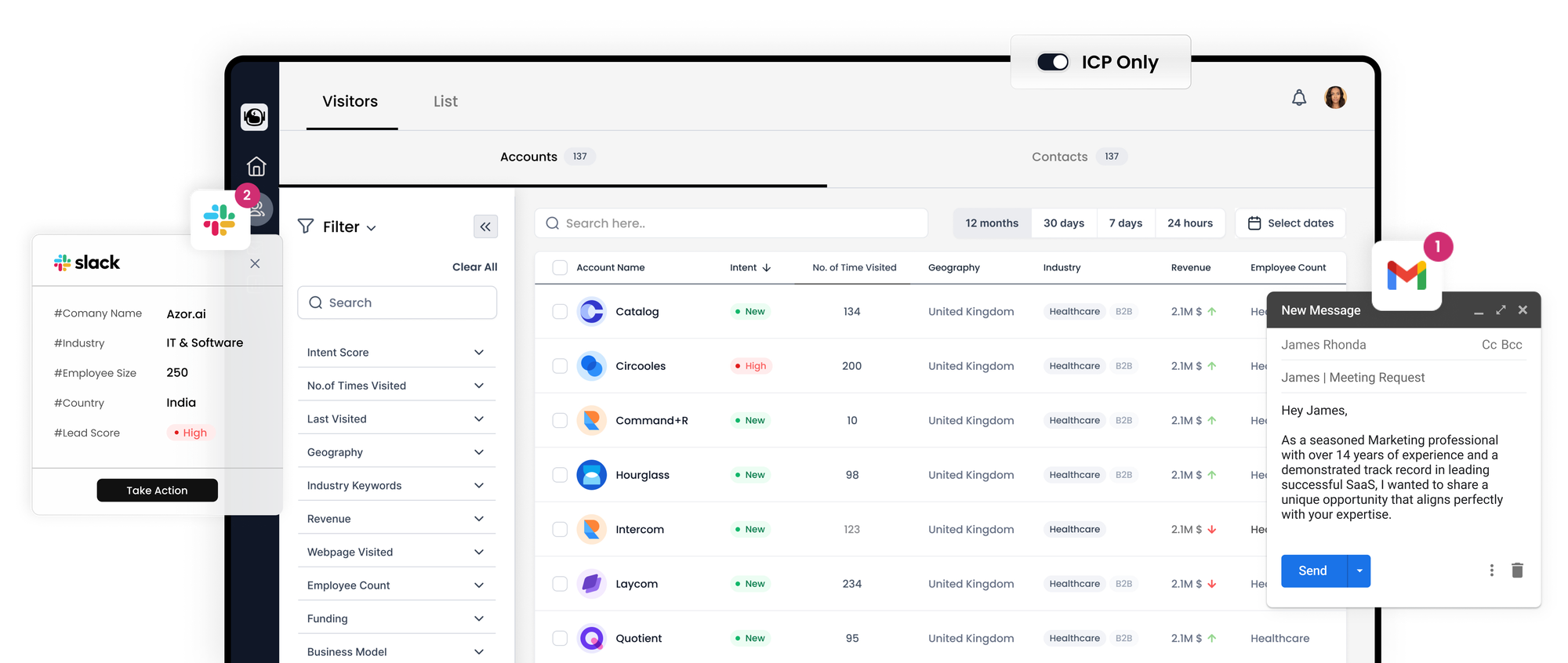Your Comprehensive Guide to Account-Based Marketing (ABM)

Navigating the realm of business-to-business (B2B) sales can be challenging, particularly when it comes to converting high-value leads. The secret lies in crafting tailored experiences that not only sway B2B decision-makers but also maximize return on investment (ROI).
Enter account-based marketing (ABM), a strategic approach uniting B2B sales and marketing efforts toward engaging precisely identified target accounts that align well with the brand's offerings. This method is gaining traction as a leading marketing practice because of its precision in pinpointing and engaging with ideal accounts. To successfully implement ABM, understanding its mechanics is essential. This guide will elucidate the concept of ABM, its advantages, and provide practical steps to formulate your ABM framework.

Understanding Account-Based Marketing
ABM is a specialized B2B marketing strategy that focuses on concerted efforts between sales and marketing teams to win over select companies, or 'accounts.' This strategy sees both teams joining forces under a unified strategy, orchestrating account-centric experiences in tandem as a single revenue-generating entity. They select a cadre of key accounts, strategize collectively, and endeavor to secure more business.
While conventional marketing often leans on broader inbound tactics, like content marketing, or lead-driven strategies that cast a wide net, ABM narrows the focus to individual influencers within an organization and synchronizes marketing maneuvers with sales initiatives.
Rather than appealing to a broad audience, ABM zeroes in on designing content specifically for targeted prospects within select organizations that your business aspires to collaborate with. This proves particularly efficacious for businesses catering to enterprise-level clients, as ABM enables targeted engagement with multiple stakeholders within a company.
Benefits of Account-Based Marketing
While account-based marketing may not be universally applicable, for B2B organizations targeting substantial enterprise accounts, it can wield formidable effectiveness. Let's delve into the notable advantages ABM bestows upon businesses.
Synchronizing Marketing and Sales
In the traditional business structure, marketing and sales are often compartmentalized, leading to a lack of coordination, conflicts, and suboptimal campaign outcomes. ABM's potency stems from its structured approach to integrating sales and marketing. This alignment not only resolves communication issues but also streamlines workflow processes. For companies grappling with aligning their sales and marketing efforts, ABM serves as a catalyst for dismantling silos and harmonizing operations.
Enhancing Customer Experience Consistency
PwC research reveals that nearly half of all consumers view consistent and dependable interactions as crucial to fostering brand loyalty. In today’s marketplace, where both B2B and B2C buyers yearn for stability in their engagements, it's imperative for companies to explore varied marketing paradigms.
By adopting ABM strategies, your business ensures that sales and marketing initiatives are in lockstep, providing leads with a seamless experience across all touchpoints. Leveraging an ABM-focused marketing platform further facilitates the delivery of uniform, high-quality interactions across various brand channels, culminating in strengthened customer trust, elevated conversion rates, and a reduction in churn.
Maximizing Return on Investment
Investing in marketing campaigns necessitates a balance between expenditure and outcomes, and it's reasonable to anticipate a profitable return on your efforts. ROI serves as a critical metric to gauge the effectiveness of a marketing strategy.
A significant proportion of B2B marketers attest to ABM's cost-effectiveness, with three-quarters affirming that ABM yields a higher ROI than any other marketing initiatives. The strategic value of ABM is increasingly recognized, evidenced by the fact that 70% of B2B marketers in prominent and medium-sized businesses are gearing up to initiate ABM tactics.
Accelerating Sales Processes
Contrary to the swift pace of B2C transactions, B2B sales are characteristically more protracted, sometimes spanning months or even years, with considerable time and resources dedicated to nurturing prospective client relationships.
ABM allows for a concentrated effort on prospects that demonstrate the highest potential for conversion into lucrative sales. Rather than dispersing attention, ABM hones in on ready-to-engage accounts. Although the B2B sales cycle may still extend over weeks or months, ABM procedures markedly compress the journey from initial interaction to the finalization of a deal.
Enhancing Content Pertinence and Cultivating Trust
In a perfect setting, leads would be graced with content precisely crafted for their distinct requirements and their position within the sales cycle. While traditional marketing often falters in this personalization, account-based marketing (ABM) adeptly ensures that leads encounter content that resonates with their specific situations.
Take, for instance, a search engine optimization firm that leverages automation to dispatch bespoke SEO analyses to the contacts at its target companies. B2B leads yearn for content that speaks directly to their challenges, and by meeting this demand, your likelihood of nurturing trust — and ultimately clinching a sale — surges.
The Mechanics of Account-Based Marketing
Having grasped the immense value of ABM, it's time to peek under the hood to comprehend how an ABM strategy functions. Despite the uniqueness of each B2B approach, certain hallmarks are universal in all ABM strategies:
Teamwork. ABM transcends beyond being a mere marketing initiative; it's a concerted effort that ropes in both the sales and marketing teams.
Mapping the Customer Journey. As a B2B entity, you're vying for a very particular customer segment. To thoroughly grasp these customers' needs, you'll craft a visual customer journey map, illustrating the steps an account traverses en route to becoming a patron. This exercise involves empathizing with the customer to pinpoint their stumbling blocks and smoothing out any potential friction points.
Meticulous Lead Qualification. The cornerstone of sharp ABM campaigns is robust lead qualification. Proponents of ABM are highly selective about their targets. Utilizing adept ABM software allows for meticulous qualification of accounts, clearly defining who is ripe for nurturing and who isn't.
Employing a Suitable ABM Platform. Without the appropriate technological support, ABM remains a pipe dream. ABM platforms endow your team with intelligent automations, AI-powered segmentation, and an integrated CRM system to translate your grand strategies into action.
To illustrate, envision running an executive coaching venture that caters to C-suite leaders. Sales and marketing would join forces to delineate goals, metrics, and strategies to allure executives from Acme, Inc. towards your services. Both teams collaborate to chart the executives' potential journey to customer hood, including avenues like referrals, website exploration, and webinar participation.
These Acme contacts are then fed into your CRM, and the relationship nurturing commences, with every interaction meticulously logged within your ABM software. The system deftly notifies the relevant team members for sales engagements, marketing materials, and other interactions that further qualify leads until Acme commits to your executive coaching offerings.
Crafting an ABM Strategy
Having grasped the fundamentals of account-based marketing (ABM), let’s delve into a structured approach for creating an ABM campaign by following these five strategic steps.
1. Selecting Target Accounts
Contrary to traditional marketing where the focus is on responding to leads, ABM proactively selects companies to engage with via customized marketing campaigns. Due to the significant investment of time and resources, it’s crucial to choose companies that promise high-value returns. This can range from a few hundred to multi-million dollar potentials.
You can also pinpoint target accounts by:
- Seeking similarities with past or current successful accounts.
- Targeting based on factors like size, revenue, or geographic location.
- Engaging with followers or readers on social platforms and blogs.
- Observing competitors' clients for potential leads.
- Scanning industry news for companies indicating potential needs for your services.
- Leveraging industry events for networking opportunities.
Typically, ABM strategies allocate a specific number of accounts to each team member, or collectively target a set of accounts as a unified group.
2. Prioritizing Prospects Within Target Accounts
Having a roster of target accounts is just the onset; pinpointing individuals within these businesses is vital. With ABM, the aim is to reach individuals who hold the power to make decisions within the context of the account’s ecosystem.
Examine your CRM for insights on influential contacts. If necessary, update your database with higher-level prospects found on platforms like LinkedIn.
3. Synchronizing Marketing and Sales Efforts
Both marketing and sales departments should collaboratively establish processes for nurturing top-tier contacts. This involves agreeing on the ICP, unified messaging, key performance metrics, technology tools to facilitate ABM, priority actions for lead qualification, and clearly defined individual responsibilities for nurturing actions.
Regular strategy sessions between sales and marketing are essential to maintain synchronicity and efficiency.
4. Generating Customized Content
The core of ABM is creating highly personalized content that resonates with each prospect in your targeted accounts. For example, you might craft a guide specifically for a C-suite leader at an office supply firm, demonstrating how you’ve achieved results for similar businesses.
Personalizing ABM might include tailored advertising, reaching out to LinkedIn contacts upon promotions, leveraging dynamic content, naming companies or individuals directly, writing personal emails, or connecting at industry events.
5. Assessing the Outcomes
Determining the effectiveness of ABM strategies can be a long-term process due to lengthy B2B sales cycles. Nevertheless, robust data analytics can facilitate timely adjustments, avoiding excessive investment in leads that may not yield expected results. Tracking real-time progress and making strategic tweaks can significantly improve the success rate of your ABM campaigns.
Leveraging ABM: Data-Driven Insights and Strategy
Account-based marketing (ABM) thrives on the insightful analysis of data, calling for meticulous tracking of key performance metrics through your ABM platform. These metrics include:
- Pipeline influenced by ABM efforts
- Engagement and interaction rates
- Email open and click-through rates
- Conversion rates
- Rates of cross-selling and upselling
- Values of annual contracts
- Customer lifetime value assessments
- Rates of successful deal closures
The success of ABM is measured more by the depth and quality of lead interactions rather than sheer volume. Typically, ABM strategies involve longer sales cycles with the potential for more substantial deals. A telltale sign of an effective ABM strategy is a noticeable increase in the average size of deals secured.
The Intersection of ABM and Inbound Marketing
ABM stands as a distinct marketing approach, yet it seamlessly integrates elements of other strategies like inbound marketing. Inbound marketing complements ABM by providing valuable content that captures leads through organic search, social media, or paid campaigns, making it an ideal precursor for ABM initiatives.
Inbound marketing lays the groundwork for a robust ABM approach, allowing you to engage prospects with the right content at the right time. This dual-strategy approach is often customized to fit a company's unique landscape. Some may lean more heavily on ABM, others on lead-based marketing, and yet some adopt a balanced blend of both, depending on the organization's size, maturity, objectives, and the nature of its offerings.
ABM in Action: Case Studies
Examining how different companies apply ABM can inspire your own strategy:
DocuSign serves as a prime example, having developed industry-specific microsites tailored to key segments and driving targeted traffic through strategic display ads. By understanding the audience for each site, DocuSign was able to curate highly relevant content that significantly boosted conversions.
Another innovative example comes from GumGum, which engaged T-Mobile by creating a custom comic book with the T-Mobile CEO as the superhero. The campaign captured attention and successfully clinched the T-Mobile account.
ABM initiatives aren't confined to the digital space. Intridea, a product design firm, strategically placed a billboard outside the Ogilvy headquarters in New York City — a bold move that paid off by grabbing Ogilvy's attention.
Crafting Your ABM Blueprint
The versatility of ABM means there are numerous ways it can be tailored to your business. Whether through precise digital targeting or creative physical advertising, ABM is all about utilizing resources effectively to bring marketing and sales into alignment and transform high-value targets into loyal customers.
To kickstart your ABM journey, sift through your leads to pinpoint those with the most potential for a personalized, high-value relationship. Rank these within your ABM system, develop collaborative workflows between sales and marketing, generate tailored content, and keep a close eye on your ABM metrics to steer your campaigns towards success.
